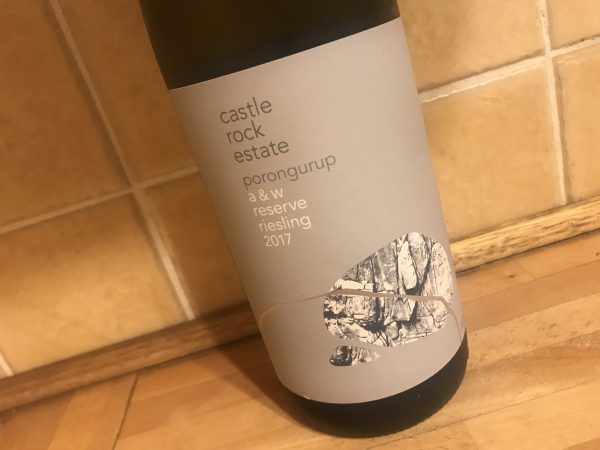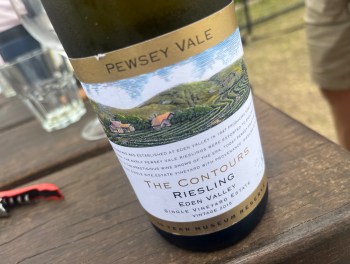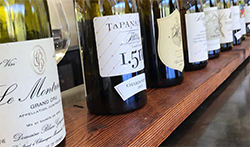It’s new release season in the wine industry, which means that I came home to a small mountain of samples to pickup from the post office. But this is new release red wine season, with a flush of 2017 reds hitting the doorstep. As a result it might seem a bit odd to be delving into Riesling releases, but it’s warm enough here in Sydney this week and I like Riesling. Who needs an excuse?
If I can point out one thing it is simply the low prices vs the scores. You want a great white wine for drinking now or in two decades, and don’t want to spend much? Buy all the Australian Riesling you can.
Harewood Estate Denmark Riesling 2018
Harewood’s array of Riesling rarely fails. But this Denmark release is up there with the Porongurup as the best of the year. It’s the density, really, that pushes this along, like grapefruit/lime concentrate (but not sweet), a little fennel and the briefest lilt of sweetness to finish. Perfectly formed and delicious Great Southern Riesling. Best drinking: Great now. 18.5/20, 94/100. 12.5%, $30. Would I buy it? Yes.
Castle Rock Estate A & W Reserve Riesling 2017
Castle Rock’s reserve Riesling and it packs a punch. I still don’t get why you’d hold it back an extra year and release it now – some of the youthful primary fruit has receded, without secondary complexity (yet). Sure, it would have been razor sharp a year ago, but that’s part of the appeal. Either release when fresh or hold back for four or five years, in my books. Anyway, this is such high quality Riesling. Handpicked, whole bunch pressed, premium wine of super intensity, even though it’s a bit gangly. Opens up with a big whack of sulphur to start, before moving into lemongrass, citrus and then a crest of mouthwatering crystalline, acidity. Such flavour! But then some awkwardness through the middle. In 2 years time this will be magnificent, but you need to hold on. Best drinking: From four years to whenever. 18/20, 93/100+. 12%, $35. Would I buy it? $35 is more than fair if you can hold on for a few years. Well worth the dollars.
Harewood Estate Frankland River Riesling 2018
Compared to the Denmark Riesling, this has more pristine fruit, if perhaps a little more shy. Still that core of grapefruit, with hints of celery. More driving acidity compared to the Denmark and a simIlar core of dense fruit. Another compelling wine, if less easy to love than the Denmark release. Best drinking: Later this year. Will be alive in many years but I prefer this style young and vital. 18/20, 93/100. 12%, $30. Would I buy it? Yes.
Taylors St Andrews Riesling 2017
A year older than the wines around it, but no lesser. Concentrated lemon lime aplenty here, the acid is firm, the finish very long and the sheer potency is great. Don’t be fooled, this is top tier, even if it’s built more for later than right now. Power! Best drinking: I’d wait for four or five years and let that wave of toast ride on in. 18/20, 93/100. 12.5%, $40. Would I buy it? One for the cellar.
St Hugo Eden Valley Riesling 2018
I’m still not sure of how this fits in the heirarchy. Does it include Steingarten vineyard fruit, but sit below Steingarten Riesling in the lineup? Regardless, it tastes like Steingarten in many ways, so let’s run with that. Dry and very reserved, it’s an ageworthy style for the future. It’s very concentrated and lemony, but hard to see the detail when it’s so firm. A work in progress, with high potential for greatness. Best drinking: The future. Five years as a start. Then it will drink well for twenty plus. 17.7/20, 92/100+. 11.5%, $39.99. Would I buy it? Someone give me a bottle so I can see what happens over time.
Pizzini Riesling 2018
King Valley Riesling that sits slightly on the greener side of the spectrum than I’d really want, but fresh enough. White flowers, lime juice and a pure palate. Fresh and crunchy, even if I want just a little more generosity. Best drinking: Now. 17.5/20, 91/100. 11.7%, $23. Would I buy it? I’d share a bottle.
Robert Stein Half Dry Riesling 2018
The most successful half dry Robert Stein Riesling to date. You barely notice the 15g RS with just a whisper of fruit tingle on the finish. Lemon/lime cordial with a tang and has a vitality to it. The dry Riesling is more refreshing, but high drinkability here still. 17.5/20, 91/100. 11.5%, $35. Would I buy it? A glass or two.
Woods Crampton Eden Valley Riesling 2018
Handpicked and whole bunch pressed, it’s a ripe styled Riesling, with sherbet and fuller lime juice. Ripe and generous but sufficiently acidic too. Good, classical Eden Riesling in a punchy style. Best drinking: Now. 17.5/20, 91/100. 13%, $21. Would I buy it? A few glasses.
Brothers at War Nothing in Common Riesling 2018
From 80yo old vines near the Eden Valley township at 400m. Just a hint of turpene development on an otherwise pure and grapefruity palate. It’s maybe a little shapeless besides the late acidity, but pleasant and easy. Just needs a little more punch but enjoyable. Best drinking: Now. 17/20, 90/100. 11%, $30. Would I buy it? A glass.
Taylors Estate Riesling 2018
Already toasty and forward, lots of lime juice but surprising in its width and toast. Great acidity and long, if a little broad through the middle. Still good quality for such widespread availability. Best drinking: Now. 16.8/20, 89/100. 12.5%, $20. Would I buy it? A glass.
Help keep this site paywall free – donate here









5 Comments
Hi Andrew, you mentioned putting some of these down for a couple of decades… I’d be reluctant
I recently pulled a 1997 Pewsey Vale Contours Riesling under screwcap from a perfect cellar. At 22 years of age it was well advanced and was starting to look necrotic all those formerly fresh tahitian lime characters came through bruised and battered, though in fairness there was still a zing in the tail.
Also recently opened was a Richmond Grove 2001 from Vintage Cellars Stelvin Initiative. In my opinion getting close to being over the hill too, with too many tertiary characters coming to the fore and only clinging to the barest glimmer of freshness.
Two examples don’t make the case, however I’d note a “soupiness” in the first reds I’d bought that were under screwcap from the early noughties too. All wines under screwcap have been cellared standing up and depending on the fill, not in contact the the Polyurethane liner.
Now I have reservations about recommending screwcap closures for that amount of cellar time. Recently I’ve heard promising things about Nomacorc, which uses raw sugar cane by products, is completely TCA free, has a lower carbon footprint and increased performance over oak derived corks.
I’d definitely argue the opposite, with verticals like this showing that screwcap ageing gives better wine even than good cork: https://ozwinereview.wpcomstaging.com/2014/07/an-ode-to-riesling-30-years-of-pauletts.html
I’m sceptical of Normacorc and the composites, with mixed results from Diam in particular.
If it was me, I’d bottle in Screwcap as first port of call, then high quality cork as second option.
That said, I don’t always like Clare and Eden Riesling with age. They just get a bit shapeless (except for the acidity).
“Buy all the Australian Riesling you can.” Words to live by.
A wise man once said. “If you buy two dozen bottles of wine. Twelve screwcap and twelve cork. The six best wines will be under cork, so will the six worst.”
To quote another, “There are no great bottles, just great corks.”
I think the jury is still out on many alternative closures. I’d agree with Diam being an inferior stopper. (Seems to scalp flavours.) I am alarmed by the development seen in the mature screwcap bottles opened and I fear that history will look back at this era in modern oenology as an anomalous blip. Better things are to come surely?!
I still can’t agree about screwcap giving alarming development – my results suggest the opposite.
Further, I’ve had Pewsey Vale sealed under screwcap from the 60s and they were glorious – much more so than if sealed under cork.
Outside of reduction issues and romance of cork, I can’t see why you wouldn’t use screwcaps.